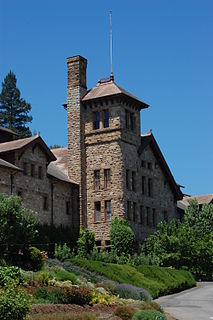
The Culinary Institute of America at Greystone is a branch campus of the private culinary college the Culinary Institute of America. The Greystone campus, located on State Route 29/128 in St. Helena, California, offers associate degrees and two certificate programs in culinary arts and baking and pastry arts. The CIA at Greystone and the Culinary Institute of America at Copia make up the school's California branch.

The Oregon Commercial Historic District is a historic district in Oregon, Illinois, that has been listed on the National Register of Historic Places since 2006. The district is roughly bordered by Jefferson, Franklin, 5th and 3rd Streets in Oregon. It is one of six Oregon sites listed on the National Register and one of three to be so listed since the turn of the 21st century. The other two are the Oregon Public Library, listed in 2003, and the Chana School, listed in 2005.
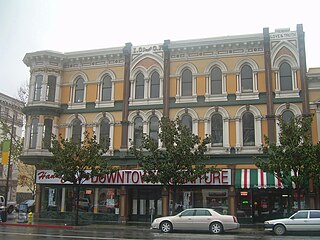
The Downtown Historic District of San Jose, California is a designated U.S. Historic District area of the city roughly the size of one square block. It is bounded by S. First Street to the west, E. San Fernando Street to the south, S. Third Street to the east, and E. Santa Clara Street to the north, but also includes the south side of E. Santa Clara Street between Third and Fourth Streets.

Central House is an 1860s hotel building located in the 800-person village of Orangeville, in Stephenson County, Illinois, United States. The building was built by Orangeville founder John Bower and operated as a hotel from its construction until the 1930s, when it was converted for use as a single family residence. The three-story building was the first commercial brick structure in downtown Orangeville. Architecturally, the building is cast in a mid-19th-century Italianate style. Central House was added to the U.S. National Register of Historic Places in 1999.

There are nine historic districts in Meridian, Mississippi. Each of these districts is listed on the National Register of Historic Places. One district, Meridian Downtown Historic District, is a combination of two older districts, Meridian Urban Center Historic District and Union Station Historic District. Many architectural styles are present in the districts, most from the late 19th century and early 20th century, including Queen Anne, Colonial Revival, Italianate, Art Deco, Late Victorian, and Bungalow.

The Brewster Building is a historic commercial building and IOOF Hall located at 201 Fourth Street in Galt, California. It was built in 1882 and was listed on the National Register of Historic Places in 2000.
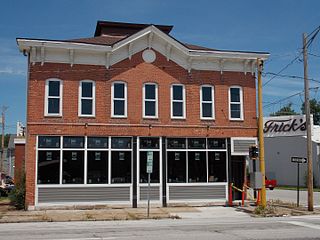
Frick's Tavern, also known as Frick's Place, is an historic building located in the West End of Davenport, Iowa, United States. It has been listed on the National Register of Historic Places since 1974. The building is a two-story brick structure that sits on the northwest corner of West Third and Fillmore Streets. It is part of a small commercial district near the historic German neighborhoods and the industrial areas along the Mississippi River. It is a typical commercial building in the West End which combined commercial space on the first floor and apartments on the second floor.
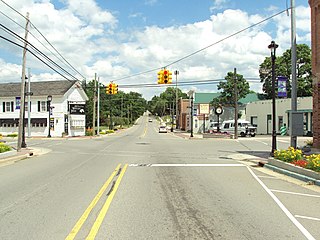
The Metamora Crossroads Historic District is a historic district centered at the intersection of Oak and High Street in the small village of Metamora in Metamora Township in Lapeer County, Michigan. It was designated as a Michigan State Historic Site and also added to the National Register of Historic Places on July 19, 1984.

The Petaluma Historic Commercial District is a 17.4 acres (7.0 ha) historic district in Petaluma, California which was listed on the National Register of Historic Places in 1995. It is located along Petaluma Boulevard, between B St. and Prospect St.

The Sam Kee Laundry Building, also known as the Pfeiffer Building, is a historic building located at 1245 Main St. in Napa, California. Built in 1875, the building is the oldest stone building and commercial building in Napa. The building has a generally simple design topped by a decorative Italianate cornice. As of 1880, the building was part of a brewery, which may have been the first brewery in Napa; it has since housed a boarding house, a saloon, and a laundry. The building currently houses the Vintner's Collective, a wine tasting bar.
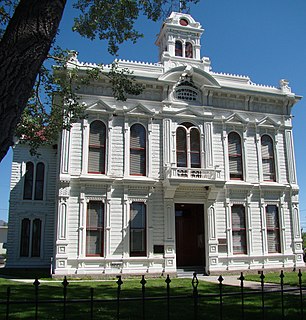
The Mono County Courthouse, on Main St. in Bridgeport, California, is a historic Italianate-style building that was built in 1880.

The Napa County Courthouse Plaza is a complex in Napa, California, which consists of the Napa County Courthouse and the Hall of Records. The two buildings occupy an entire city block, which includes open areas and landscaping to create the site's plaza setting. The High Victorian Italianate courthouse was built in 1878 to replace the original 1856 courthouse. The courthouse continues to serve as the seat of Napa County government. The 1916 Hall of Records is a federally sponsored records building designed by William H. Corlett. The Renaissance Revival building represents an early use of reinforced concrete as a building material; the material became popular nationwide in the 1920s.

Goshen Historic District is a national historic district located at Goshen, Elkhart County, Indiana. The district encompasses 751 contributing buildings and 1 contributing site in the central business district and surrounding residential sections of Goshen. The town was developed between about 1840 and 1930, and includes notable examples of Italianate and Queen Anne style architecture. Located with in the district are the separately listed Elkhart County Courthouse and Goshen Carnegie Public Library. Other notable buildings include the Kindy Block (1881), Central Block (1882), Spohn Building (1909), Harper Block (1888), Noble Building, Jefferson Theater (1907), General Baptist Church (1859), First Methodist Church (1874), and St. James Episcopal Church (1862).

The Park-to-Park Residential Historic District in Fort Madison, Iowa, United States, was listed on the National Register of Historic Places in 2014. The historic district is located to the north of the Downtown Commercial Historic District, generally between Central Park on the west and Old Settler's Park on the east. Both parks are contributing sites. For the most part the district is made up of single family homes built in the late 19th and early 20th centuries. Some of these homes were built as rental properties, while others became so in later years. The Albright House and the Chief Justice Joseph M. Beck House are contributing properties, and they are also individually listed on the National Register. There are also duplexes and a few small scale apartment buildings in the district.

The Lesinger Block, also known as Little Bohemia, is a historic building located in Cedar Rapids, Iowa, United States. This building was constructed at a time of economic expansion in the city. It is a contemporary of several Italianate commercial blocks that were built downtown. Because of subsequent development in that commercial district those buildings have been replaced with newer structures leaving this building as the best extant example of commercial Italianate in Cedar Rapids. It was constructed by Vaclav Lesinger, an immigrant from Kozlov, Bohemia. He was a tailor by trade and he had this structure built in 1883 to house his tailor shop and a dry goods store. Since 1907 the building has housed a tavern that has served as a social center for the local Bohemian community. Architecturally, the two-story brick structure still retains a good deal of its original wood ornamentation, including the sawtooth frieze above the storefronts and the geometric design in the bracketed cornice.
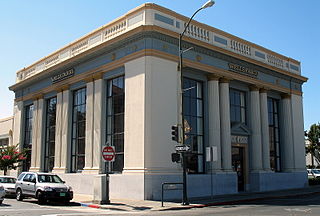
The Bank of Napa, at 903 Main St. and 908 Brown St. in Napa, California was built in 1923. It was listed on the National Register of Historic Places in 1992.

The Buford House in Napa, California, at 1930 Clay St., was built in 1877. It was listed on the National Register of Historic Places in 1977.

The Capt. N. H. Wulff House, at 549 Brown St. in Napa, California, was built in 1885. It was listed on the National Register of Historic Places in 1992.
Luther M. Turton was an architect in Napa, California. A number of his works are listed on the National Register of Historic Places.

The Winship-Smernes Building, at 948 Main St. in Napa, California, was built in 1888. It was designed by Napa architect Luther Turton in Italianate style. It was listed on the National Register of Historic Places in 1977.




















